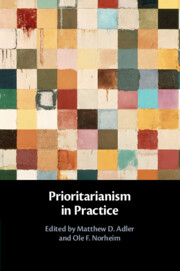Book contents
- Prioritarianism in Practice
- Prioritarianism in Practice
- Copyright page
- Contents
- Figures
- Tables
- List of Contributors
- 1 Introduction
- 2 Theory of Prioritarianism
- 3 Well-Being Measurement
- 4 Prioritarianism and Optimal Taxation
- 5 Prioritarianism and Measuring Social Progress
- 6 Prioritarianism and Health Policy
- 7 Prioritarianism and Fatality Risk Regulation
- 8 Prioritarianism and Climate Change
- 9 Prioritarianism and Education
- 10 Empirical Research on Ethical Preferences: How Popular is Prioritarianism?
- 11 Prioritarianism and Equality of Opportunity
- 12 Prioritarianism and the COVID-19 Pandemic
- Index
- References
4 - Prioritarianism and Optimal Taxation
Published online by Cambridge University Press: 09 June 2022
- Prioritarianism in Practice
- Prioritarianism in Practice
- Copyright page
- Contents
- Figures
- Tables
- List of Contributors
- 1 Introduction
- 2 Theory of Prioritarianism
- 3 Well-Being Measurement
- 4 Prioritarianism and Optimal Taxation
- 5 Prioritarianism and Measuring Social Progress
- 6 Prioritarianism and Health Policy
- 7 Prioritarianism and Fatality Risk Regulation
- 8 Prioritarianism and Climate Change
- 9 Prioritarianism and Education
- 10 Empirical Research on Ethical Preferences: How Popular is Prioritarianism?
- 11 Prioritarianism and Equality of Opportunity
- 12 Prioritarianism and the COVID-19 Pandemic
- Index
- References
Summary
Prioritarianism has been at the center of the formal approach to optimal tax theory since its modern starting point in Mirrlees (1971), but most theorists’ use of it is motivated by tractability rather than explicit normative reasoning. We characterize analytically and numerically the implications of a more explicit use of prioritarianism in optimal tax theory. We also examine prevailing tax policies and surveys on tax preferences to gauge the influence of prioritarianism in practice. We conclude that optimal policy is highly sensitive to many key modeling choices and parameter assumptions, and these choices interact in complicated ways, but that a substantial shift in policy results if the social objective moves from utilitarian to prioritarian. When looking at existing policy and preferences, we find only limited evidence of prioritarian reasoning. We conclude with suggestions on the future of prioritarianism in optimal tax theory.
- Type
- Chapter
- Information
- Prioritarianism in Practice , pp. 172 - 203Publisher: Cambridge University PressPrint publication year: 2022
References
- 2
- Cited by

